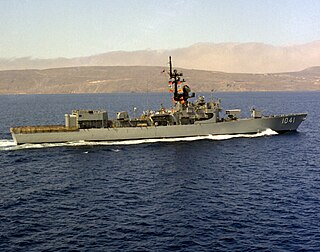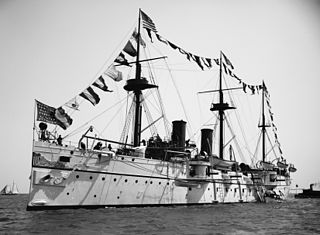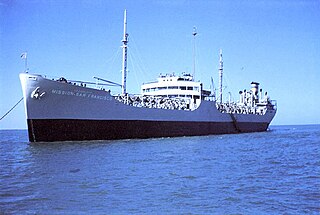
USS Colorado (BB-45) was a battleship of the United States Navy that was in service from 1923 to 1947. She was the lead ship of the Colorado class of battleships. Her keel was laid down on 29 May 1919, by the New York Shipbuilding Corporation. She was launched on 22 March 1921, and commissioned on 30 August 1923. She was armed with eight 16-inch (406 mm) guns and fourteen 5-inch (127 mm) deck guns; two 5-inch guns were removed in an overhaul.

The fifth USS Boston was a protected cruiser and one of the first steel warships of the "New Navy" of the 1880s. In some references she is combined with Atlanta as the Atlanta class, in others as the Boston class.

USS Bradley (FF-1041) was the second of ten 2,620-ton Garcia-class destroyer escorts, later reclassified as frigates, in the United States Navy. She was named for Captain Willis Winter Bradley, Jr.. She was later sold into the Brazilian Navy as Pernambuco .

Neptune was a Bucentaure-class 80-gun ship of the line of the French Navy. Built during the last years of the French Revolutionary Wars she was launched at the beginning of the Napoleonic Wars. Her brief career with the French included several major battles, though she spent the last 12 years of her life under the Spanish flag.

USS Slater (DE-766) is a Cannon-class destroyer escort that served in the United States Navy and later in the Hellenic (Greek) Navy. The ship was named for Frank O. Slater of Alabama, a sailor killed on the cruiser USS San Francisco during the Naval Battle of Guadalcanal. He was posthumously awarded the Navy Cross for gallantry in action and the Purple Heart. Following service during World War II, the ship was transferred to Greece and renamed Aetos. Decommissioned in 1991, the destroyer escort was returned to the United States.

Pluton was a Téméraire class 74-gun French ship of the line built at Toulon. She was one of two prototypes for a derivative sub-class of the original design; this sub-class was specially intended for construction in some of the shipyards in states occupied by the French, where there was less depth of water than in the main French shipyards. Although the Pluton were built at Toulon, all other vessels of this sub-class were built in these overseas yards, notably at Antwerp but also at Genoa, Trieste, Venice, Amsterdam, Flushing and Rotterdam.

The Battle of Cape Passaro was the defeat of a Spanish fleet under Admirals Antonio de Gaztañeta and Fernando Chacón by a British fleet under Admiral George Byng, near Cape Passero, Sicily, on 11 August 1718, four months before the War of the Quadruple Alliance was formally declared.

San Juan Nepomuceno was a Spanish ship of the line launched in 1765 from the royal shipyard in Guarnizo (Cantabria). Like many 18th century Spanish warships she was named after a saint. She was a solidly built ship of proven seaworthy qualities. Captured by the British Royal Navy during the Battle of Trafalgar, the ship was renamed first HMS Berwick, then HMS San Juan. The ship was discarded in 1816.

The first USS San Francisco (C-5) was a steel protected cruiser in the United States Navy. She was later named Tahoe and then Yosemite, becoming the third US Navy ship to bear the name Yosemite. She generally resembled her predecessor Newark, with a main armament of twelve 6-inch guns.

USNS Mission San Francisco (T-AO-123) was a Mission Buenaventura-class oiler that served in the United States Navy. The ship was originally intended as USS Contoocook (AO-104) for the U.S. Navy but her acquisition was canceled. The ship, a Type T2-SE-A3 tanker, was completed as SS Mission San Francisco and delivered after the end of World War II. The tanker was acquired by the U.S. Navy in 1947 as USS Mission San Francisco (AO-123), but was transferred to the Military Sea Transport Service (MSTS) upon its creation in 1949. During a second stint with the MSTS that began in 1954, Mission San Francisco collided with the freighter Elna II in the Delaware River coast and was declared unsalvageable by the U.S. Navy. The ship was one of two U.S. Navy vessels named for the Franciscan mission of San Francisco de Asís located in San Francisco, California.

SS Mission Dolores was a Mission Buenaventura-class oiler built for the United States Maritime Commission during World War II, named for Mission San Francisco de Asís in San Juan Capistrano, California, one of two named for the Franciscan mission located in San Francisco, California.

USS Audubon (APA-149) was a Haskell-class attack transport acquired by the U.S. Navy during World War II for the task of transporting troops to and from combat areas.

Yerba Buena was the original name of the settlement that later became San Francisco, California. Located near the northeastern end of the San Francisco Peninsula, between the Presidio of San Francisco and the Mission San Francisco de Asís, it was originally intended as a trading post for ships visiting San Francisco Bay. The settlement was arranged in the Spanish style around a plaza that remains as the present day Portsmouth Square.

HMS Blossom was an 18-gun Cormorant-class sloop-of-war. She was built in 1806 and is best known for the 1825–1828 expedition under Captain Beechey to the Pacific Ocean. She explored as far north as Point Barrow, Alaska, the furthest point into the Arctic any non-Inuit had been at the time. She was finally broken up in 1848.

Furet was an Abeille-class 16-gun brig of the French Navy, launched in 1801. HMS Hydra captured her on 27 February 1806, off Cadiz.
Neptuno was an 80-gun Montañes-class ship of the line of the Spanish Navy. She was built in 1795 and took part in the French Revolutionary and Napoleonic Wars. She fought with the Franco-Spanish fleet in the battle of Trafalgar, and was wrecked in its aftermath.

The Action of 25 January 1797 was a minor naval battle of the French Revolutionary Wars, fought in the Gulf of Cádiz. The Spanish third-rate ship of the line San Francisco de Asís was attacked and pursued for several hours by a British squadron of three fifth-rates frigates and a sixth-rate corvette under George Stewart, 8th Earl of Galloway. After an intermittent but fierce exchange of fire, the British warships, badly damaged, were eventually forced to withdraw. The San Francisco de Asís, which suffered only minor damage, was able to return to Cádiz without difficulties. The commander of the ship, Captain Alonso de Torres y Guerra, was promoted for his success.

The battle of Cape Celidonia took place on 14 July 1616 during the Ottoman-Habsburg struggle for the control of the Mediterranean when a small Spanish fleet under the command of Francisco de Rivera y Medina cruising off Cyprus was attacked by an Ottoman fleet that vastly outnumbered it. Despite this, the Spanish ships, mostly galleons, managed to repel the Ottomans, whose fleet consisted mainly of galleys, inflicting heavy losses.



















